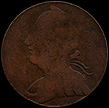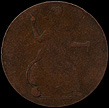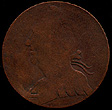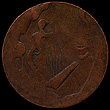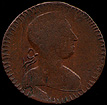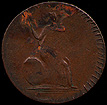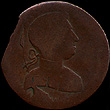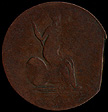Blacksmith Coppers
obverse |
|
reverse |
| |||
Wood 11 Blacksmith Copper
Weight: 82.8 g (5.36 grams) Diameter: 27.4 mm
Comments: This coin has a bust left obverse with a Britannia facing right reverse. Oppenheim suggests this is one of the late issues as it is fairly common (estimated population of 250+) and is often found in better condition. The present example is in excellent condition for a Blacksmith, showing as much detail as the Baker example. Note that the outline of the bust was rather deeply cut in the die and is well defined while the central portion is weak. The same is true on the reverse where the extremities are clearly defined but the center of the body is weak. The obverse is similar to Wood 1 but can be easily distinguished by the open mouth on the bust. This obverse die (used for Wood 11) was also used for Wood 12, (see the following example). Charlton number BL-7 where it lists a weight range of 5.0 to 5.4 grams and a diameter of 27.4 mm.
Provenance: Donated to Notre Dame in 1887 as part of a 2,300 item coin collection (see: The Notre Dame Scholastic, vol. 21 (September 1887) 45.
obverse |
|
reverse |
| |||
Wood 12 Blacksmith Copper
Weight: 77.5 g (5.01 grams) Diameter: 27.4 mm
Comments: This coin has the same bust left obverse as found on Wood 11 but is combined with the Irish harp reverse. As with the previous Wood 11 example this is a late issues which is slightly less common than the previous example (estimated population of 150+). The present example shows significant detail. Note that the outline of the bust was rather deeply cut in the die and is well defined while the central portion is weak. The reverse had a very well defined harp, except for the shallow cut die at the top of the harp. The harp has seven strings, six sogether in the center and one shorter string to the far right. The Charlton catalog states the reverse die was severly cracked. I am not sure if the design around the edge is intentional or due to massive die breaks. Possibly it was intentional to mimic worn legends or rim die breaks. Charlton number BL-8 where it lists a weight of 4.6 grams and a diameter of 27.2 mm.
Provenance: Donated to Notre Dame in 1887 as part of a 2,300 item coin collection (see: The Notre Dame Scholastic, vol. 21 (September 1887) 45.
obverse |
|
reverse |
| |||
Wood 23, early state Blacksmith Copper
Weight: 84.1 g (5.46 grams) Diameter: 27.0 mm
Comments: This item is one of a group of coppers associated with the reuse of two Hard Times token dies that had originally been produced by Daniel and Benjamin True of Troy, New York about 1835. See the introduction for more on this group. This variety has a bust left obverse with a distinctive die break that begins at about 11:00 o'clock. In the area behind the head the crack touches two denticles, it does not have much thickness but is wide in the form of a triangle. The crack become rather thin and moves down behind the bust. It passes through the edge of the bust where it widens and thickens into what is actually a void in the die near the rim at about 6:00 - 7:00 o'clock, creating a rather pronounced blob on the coin. This is an early state of the die as the crack is a thin line. For a later state see the next example. Note that this obverse looks similar to the Machin Mill's coins with a rim design composed of large triangular denticles.
The reverse displays a seated Britannia facing right. There is a denticle border design from the upper end of Britannia's spear to just below her feet. Several rust marks are present on the reverse. At later states in its life this reverse was extensively recut. The present example is in excellent condition and shows significant detail. Over eight different states of this die have been observed with late examples being reduced in size to as small as 26.5mm and weighing only 3.67 grams! Charlton number BL-40 where it lists a weight range of 3.6 to 5.8 grams and a diameter range of 26.5 to 28.1 mm.
Provenance: Donated to Notre Dame in 1887 as part of a 2,300 item coin collection (see: The Notre Dame Scholastic, vol. 21 (September 1887) 45.
obverse |
|
reverse |
| |||
Wood 23, intermediate state Blacksmith Copper
Weight: 99.9 g (6.49 grams) Diameter: 28.0 mm
Comments: This item is one of a group of coppers associated with the reuse of two Hard Times token dies that had originally been produced by Daniel and Benjamin True of Troy, New York about 1835. See the introduction for more on this group. It has a bust left obverse with a distinctive die break that begins at about 11:00 o'clock and moves down behind the bust. It passes through the edge of the bust where it widens and thickens into what is actually a void in the die near the rim at about 6:00 - 7:00 o'clock, creating a rather pronounced blob on the coin. This example is an intermediate or middle state of the die. When compared to the previous example one can see that the thin line behind the head on the previous example has become much thicker in this example; also the void area at the bottom of the coin has widened so that it has engulfed more rim denticles to the right. In later states the entire length of the crack thickens and widens and the void area progresses somewhat more to the right but enlarges even more to the left going to the edge of the shoulder. Although this example is more worn than the previous coin the size of the planchet and weight are close to the upper limits for this coin, therefore it is most likely the planchet was clipped before striking.
The reverse displays a seated Britannia facing right. Because of rust spots on the die the reverse was recut. Notice the denticle border design visible near the feet of Britannia. The denticles are much wider than on the previous example and are positioned differently. Note the large denticles below the line and to the right of Britannia's feet. One can also see that the head is rounder here while it is more oblong in the earlier example. Also the neck and shoulders difffer from that in the earlier state. Charlton number BL-40 where it lists a weight range of 3.6 to 5.8 grams and a diameter range of 26.5 to 28.1 mm.
Provenance: Donated to Notre Dame in 1887 as part of a 2,300 item coin collection (see: The Notre Dame Scholastic, vol. 21 (September 1887) 45.
| Unattributed Imitation British Coppers | Section Contents | Blacksmith Coppers, p. 2 |
|
For viewing tips and information on optimal computer settings click
here.
For questions or comments contact Special Collections by: |
